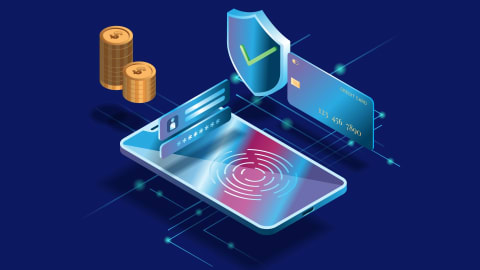In today's hyper-connected world, digital banking has become an indispensable part of our lives. From paying bills to managing investments, we rely on digital platforms for seamless and convenient transactions.
However, this increased reliance on digital channels also raises security concerns. This is where the power of biometric technology in digital banking comes into play, offering a robust and reliable solution to safeguard financial assets and user data.

This explosive growth underscores the increasing importance of biometric security in digital banking. This article explores the transformative role of biometrics in banking, examining how biometric security in digital banking is reshaping the industry and providing a more secure future for financial transactions.
We'll delve into the various applications of biometric technology in digital banking, discuss the benefits of banking solutions using biometrics, and analyze the critical role digital banking security in biometric authentication plays in protecting against fraud and unauthorized access.
Let’s start!
What is Biometric Security in Digital Banking?
Biometric security in digital banking involves using unique biological characteristics, such as fingerprints, facial recognition, iris scans, or voice recognition, to authenticate users and authorize transactions within digital banking platforms. Instead of relying solely on traditional passwords or PINs, biometrics adds an extra layer of security, making it significantly harder for fraudsters to access sensitive financial information.
This technology leverages advanced algorithms and sensors to capture and analyze these unique identifiers, ensuring that only authorized individuals can access their accounts and perform transactions. Biometric technology in digital banking is increasingly becoming a standard feature, offering a more secure and user-friendly alternative to traditional authentication methods.
Types of Biometric Authentication Used in Digital Banking
To incorporate biometric security, organizations must collect unique biometric data. Biometric banking methods fall into three main categories: morphological, biological, and behavioral.
- Morphological biometrics focus on body structures, such as fingerprints or facial shape recognition.
- Biological biometrics involve genetic and molecular characteristics, ranging from DNA to blood.
- Behavioral biometrics relate to habits, making voice recognition increasingly popular in financial institutions. Bank verifications and identifications typically utilize morphological traits like fingerprints or facial scanning.
In addition to these, banks often employ finger/palm vein readers and iris scanners. Voice recognition is a rising trend in behavioral biometrics for financial institutions today.
The Role of Biometrics in Banking Security
The role of biometrics in banking security is paramount in today's digital age. Traditional authentication methods, such as passwords and PINs, are often vulnerable to breaches and phishing attacks. Biometric security in digital banking addresses these vulnerabilities by providing a more robust and personalized form of authentication.
Here are some key ways to enhance banking security with biometrics:

- Enhanced Security: Biometric implementations against unauthorized access are challenging. They provide an essential physical presence in the form of biometrics to identify the actual user, for example, in cases of fingerprinting or face recognition.
- Reduced Fraud: By verifying the user's identity through unique biological traits, biometrics helps prevent fraudulent transactions and account takeover.
- Improved User Experience: Biometric technology will provide more seamless and user-friendly digital banking than the previous methods of authentication. Forgetting complex passwords or PIN codes is no longer necessary.
- Increased Trust: The high use of biometrics in financial services also helps to improve the individual's trust in digital platforms that inform the individual that their financial data is safe.
- Compliance with Regulations: Compliance With Regulations: Many regulatory bodies are encouraging or mandating strong authentication methods, including biometrics, to cater to the security of the financial sector. Thus, the banking solutions that use biometrics meet compliance criteria.
Benefits of Biometric Solutions in Digital Banking
Banking solutions using biometrics offer a wide range of benefits for both financial institutions and their customers. Some of the benefits of biometrics for banks are as follows:-
- Enhanced Security: As discussed, biometrics provides a higher security level than traditional authentication methods.
- Improved Customer Experience: Biometrics simplifies the biometrics-based authentication for banks process, making it faster and more convenient for customers.
- Reduced Operational Costs: By reducing fraud with biometrics in banking and improving efficiency, it can help financial institutions lower operational costs.
- Increased Customer Satisfaction: The convenience and security biometrics offers can lead to higher customer satisfaction and loyalty.
- Competitive Advantage: Financial institutions that offer biometric Biometrics-based authentication for banks can gain a competitive edge, especially in competitive markets like the US and Canada.
- Streamlined Transactions: Biometric technology in digital banking can significantly streamline transactions, reducing the time and effort required for authentication.
- Accessibility: Biometrics can make banking more accessible to individuals with disabilities who may find it challenging to use traditional biometrics-based authentication for bank methods.
Implementing Biometric Security in Digital Banking
Implementing biometric security in digital banking requires careful planning and execution. Financial institutions, particularly startups and CXOs, need to consider various factors, including:

Choosing the Right Biometric Modality:
Biometric modality selection should be driven by a consideration of cost, accuracy, user acceptance, and specific needs of the banking application, as familiarity with fingerprint and face recognition should be taken into account in relation to the US and Canadian markets.
Integration with Existing Systems:
An effective biometric system should be able to integrate with an existing banking platform infrastructure without issues. For start-ups intending to increase their scale fairly fast, this proves imperative.
Data Security and Privacy:
Protecting users' biometric data is a necessity. Robust security measures against unauthorized access and misuse should be instituted by financial services institutions, with compliance with US and Canadian regulations.
User Education and Awareness:
Educating users about the benefits and security of biometrics is essential for successful adoption. Clear communication is key, especially for tech-savvy audiences in the US and Canada.
Scalability Factors:
In implementing biometrics in banking systems, the biometric system should be scalable to accommodate future growth and increase transaction volumes, which is a critical consideration for startups.
Multi-Factor Authentication:
Combining biometrics with another authentication type, such as one-time passwords, also offers an even higher level of security. This is also the basis for multi-factor authentication, which is essential for security in digital banking in the deployment of biometrics.
Use Cases of Biometrics in Banking
Biometric technology is transforming various aspects of banking, offering innovative solutions for enhanced security, streamlined processes, and improved customer experiences.
Here are some key use cases of biometrics in financial services:

Account Access:
Mobile apps or online banking platforms now offer biometric authentication mechanisms such as fingerprinting, or rather facial recognition for banking security, to render customers secure yet convenient access to their accounts, eliminating the need to memorize selected bank account passwords that are usually complex, thereby reducing the phishing threat and the possibility of unauthorized access.
Transaction Authorization:
Biometric authorizations for transactions should be applicable for high-value payments or sensitive operations. These may include fingerprint verification, facial recognition, or voice recognition to confirm transactions.
Fraud Prevention:
Biometric systems can detect anomalies in user behavior, such as unusual login locations or transaction patterns, which may indicate fraudulent activity. This allows banks to flag suspicious activity and prevent potential losses proactively. Behavioral biometrics, which analyzes typing patterns, mouse movements, and other user interactions, plays a crucial role here.
Customer Onboarding:
Using biometrics in the customer onboarding process, therefore, means remote identity verification. A new customer will take pictures of their ID using a smartphone camera and verify their identity through facial recognition, thus never having to visit a branch.
Branch Security:
Access control in a bank branch may limit entry into sensitive areas, including vaults or server rooms, to authorized personnel. Fingerprint or iris scans may be used to control such access, ensuring only approved individuals may enter the restricted areas.
ATM Transactions:
Integration of biometrics with ATMs can ensure cardless transactions. Customers, through fingerprints or facial recognition, will now withdraw cash or conduct other ATM business with zero risk of card skimming, promoting transaction speed.
Personalized Services:
Biometrics will enable the customization of banking services based on individual customer preferences. For example, banks can use facial recognition to identify customers as they walk into the branch and adjust their offerings accordingly.
Loan Applications:
Biometric authentication can simplify loan applications in banking by allowing applicants to sign and verify their identity digitally and remotely. This will expedite loan approval and reduce paperwork.
Contactless Payments:
Biometrics have begun to be increasingly adopted in contactless payment mechanisms, which allow customers to authorize a payment using either a fingerprint or facial recognition at the point-of-sale terminal. This provides a secure alternative to conventional methods.
Employee Authentication:
Banks can use biometrics to authenticate employee access to internal systems and sensitive data. This helps to prevent unauthorized access and protect confidential information.
Biometric Authentication Methods in Banking
The financial sector increasingly turns to biometrics to enhance security and streamline customer experiences. These technologies leverage unique biological traits to verify the identity of users, offering a robust alternative to traditional passwords and PINs.
Here are some of the key methods of biometric authentication in banking:
1. Fingerprint Recognition:
- How it works: Fingerprint scanners capture the unique pattern of ridges and valleys on a user's fingertip.
- Banking Use: Widely used for mobile banking app logins, authorizing transactions, and accessing secure areas within bank branches or ATMs.
- Benefits: Relatively low cost, mature technology, user familiarity.
2. Retina Scanners:
- How it works: Retina scanners analyze the unique patterns of blood vessels in the retina at the back of the eye.
- Banking Use: While less common due to cost and intrusiveness, retina scans offer high accuracy and are sometimes used in high-security applications or for privileged access within financial institutions.
- Benefits: Extremely accurate.
3. Iris Scanners:
- How it works: Iris scanners analyze the complex patterns in the colored portion of the eye (the iris).
- Banking Use: Similar to retina scans, iris scanning is highly accurate and can be used for high-security access control or in specialized banking scenarios.
- Benefits: Very high accuracy, contactless (unlike retina scans).
4. Speech Recognition:
- How it works: Speech recognition analyzes the unique characteristics of a user's voice, including pitch, tone, cadence, and accent.
- Banking Use: Used for voice banking services, phone-based authentication, or potentially for hands-free authentication in specific banking environments.
- Benefits: Convenient, hands-free option.
5. Facial Recognition:
- How it works: Facial recognition technology maps the unique features of a person's face, such as the distance between eyes, nose shape, and jawline.
- Banking Use: Used for mobile banking app logins, ATM authentication, and potentially for in-branch customer recognition and personalized service.
- Benefits: Contactless, convenient.
6. Finger Vein Recognition:
- How it works: This technology captures the vein patterns in the fingers using near-infrared light.
- Banking Use: Offers a high level of security and is less susceptible to forgery than fingerprint scanning. It can be used for access control or transaction authorization.
- Benefits: High accuracy, less susceptible to forgery.
The choice of method biometric authentication in banking depends on various factors, including the specific application, the level of security required, cost considerations, user experience, and user acceptance. Banks often employ a combination of biometric methods to create a multi-layered security approach.
How Biometrics Improve Digital Banking Security: The Key to Success
For startup owners and CXOs in the US and Canadian markets, embracing top biometrics technologies in banking isn't just about security; it's a strategic move. In a landscape where customer experience and data protection are paramount, biometrics offers a distinct competitive advantage.
By implementing robust banking solutions using biometrics, startups can:
- Attract and Retain Customers: Offering cutting-edge biometric authentication demonstrates a commitment to security and innovation, attracting tech-savvy customers who value convenience and data protection.
- Build Trust and Credibility: In a market saturated with data breaches, biometric security reinforces trust and credibility, which are essential for building a strong brand reputation.
- Reduce Fraud Losses: By minimizing fraudulent transactions, biometrics can significantly reduce financial losses and protect the company's bottom line.
- Streamline Operations: Biometric authentication can streamline internal processes, improving efficiency and reducing administrative overhead.
- Gain a Market Advantage: Being at the forefront of biometric adoption can differentiate a startup from its competitors, positioning it as a leader in the digital banking space. This is particularly relevant in the competitive US and Canadian markets.
- Enhance Customer Lifetime Value: By providing a superior and secure user experience, startups can increase customer satisfaction and loyalty, leading to higher customer lifetime value.
PRO TIPS:- Financial institutions operating in the US and Canada must comply with various data privacy and security regulations. This includes adhering to regulations like GDPR (even for Canadian companies dealing with EU citizens' data), CCPA in California, and PIPEDA in Canada.
These regulations emphasize the importance of data protection and require organizations to implement robust security measures, including strong authentication methods. Biometric security in digital banking can help financial institutions meet these compliance requirements and avoid hefty penalties.
Addressing the Challenges of Biometric Implementation
While top biometrics technologies in banking offer numerous advantages, some challenges need to be addressed:
- Data Privacy Concerns: Collecting and storing biometric data raises privacy concerns. Financial institutions must comply with all relevant data privacy regulations and implement robust security measures to protect user data, especially in light of GDPR and similar regulations in the US and Canada.
- Accuracy and Reliability: Biometric systems are not always perfect. Environmental conditions, user behavior, and device limitations can affect the accuracy of biometric scans.
- Cost of Implementation: Implementing biometric systems, particularly for smaller financial institutions, can be expensive. However, the long-term benefits often outweigh the initial costs.
- User Acceptance: Some users may hesitate to adopt biometrics due to privacy concerns or fear of technology. Addressing these concerns through education and transparency.
- Spoofing Attacks: Sophisticated fraudsters may attempt to create fake biometric identifiers, such as fake fingerprints or facial masks, to bypass biometric authentication. Robust digital banking security in biometric implementations must include anti-spoofing measures. Regularly updating security protocols and employing liveness detection technologies are crucial.
Financial software development services for banking using biometrics represent an incremental improvement and a fundamental shift towards a more secure and user-centric future for digital finance.
The increasing importance of enhancing banking security with biometrics makes it clear that this technology is not just a trend but a core component of the future of banking.
The Future of Biometric Technology in Digital Banking
The future of biometrics in digital banking is constantly evolving. We can expect to see even more innovative applications of biometrics in the future, such as:

- Behavioral Biometrics: The use of behavioral biometrics for continuous authentication is expected to grow, providing a more seamless and secure banking experience.
- Voice Biometrics: Voice biometrics will likely become more prevalent, offering a convenient and hands-free authentication option.
- Integration with Wearable Devices: Biometric authentication may be integrated with wearable devices, such as smartwatches and fitness trackers, further enhancing convenience.
- Blockchain Biometrics: Combining blockchain technology with biometrics can create a highly secure and transparent system for identity verification and transaction authorization.
- AI-Powered Biometrics: Artificial intelligence (AI) can be used to enhance the accuracy and efficiency of biometric systems and detect and prevent fraud.
The future of digital banking is undoubtedly biometric-enabled secure transactions. As the future of biometrics in digital banking continues to evolve, we can expect to see even more sophisticated and innovative applications of biometrics. From behavioral biometrics to AI-powered authentication, the possibilities are endless. Financial institutions that embrace biometric technology in digital banking will be well-positioned to thrive in this evolving landscape.
This includes startups and established players, particularly in the competitive US and Canadian markets. Enhancing banking security with biometrics is not just a trend; it's the foundation of a secure and user-centric future for finance.
Choose VLink's Financial Expertise for Your Biometric Mobile App Development
For secure and user-friendly biometric mobile app development, choose VLink. Our finance and mobile app development expertise makes us the ideal partner. We understand the financial landscape, including regulations and security best practices, and our experienced developers are proficient in the latest mobile technologies, specializing in biometric integration.
With a security-first approach, user-centric design, and agile or waterfall methodology, we deliver high-quality, custom solutions tailored to your needs. We specialize in helping startups and established financial institutions in the US and Canadian markets leverage the power of biometrics to enhance security, improve customer experience, and gain a competitive edge.
Our dedicated team of experts can guide you through selecting, implementing, and managing biometric solutions tailored to your unique requirements to build financial software. Don't wait – secure your digital future with biometrics.
Conclusion: Partnering for a Secure Digital Banking
Biometric technology in digital banking is revolutionizing how we interact with our finances. By offering a more secure, convenient, and user-friendly authentication experience, biometrics is playing a critical role of biometrics in banking security.
As technology continues to advance digital banking through biometrics, we can expect to see even more innovative applications of biometrics in the future. While there are challenges to overcome, the benefits of biometric security in digital banking are clear.
By embracing this technology, financial institutions can enhance security, improve customer experience, and build trust in the digital banking ecosystem. As top biometric technology in banking continues to mature, it will play an increasingly important role in protecting our financial assets and ensuring the integrity of the digital banking system.
Ready to explore how biometric solutions can transform your digital banking platform? Contact us today to explore the power of biometrics for your business.










 Shivisha Patel
Shivisha Patel

















